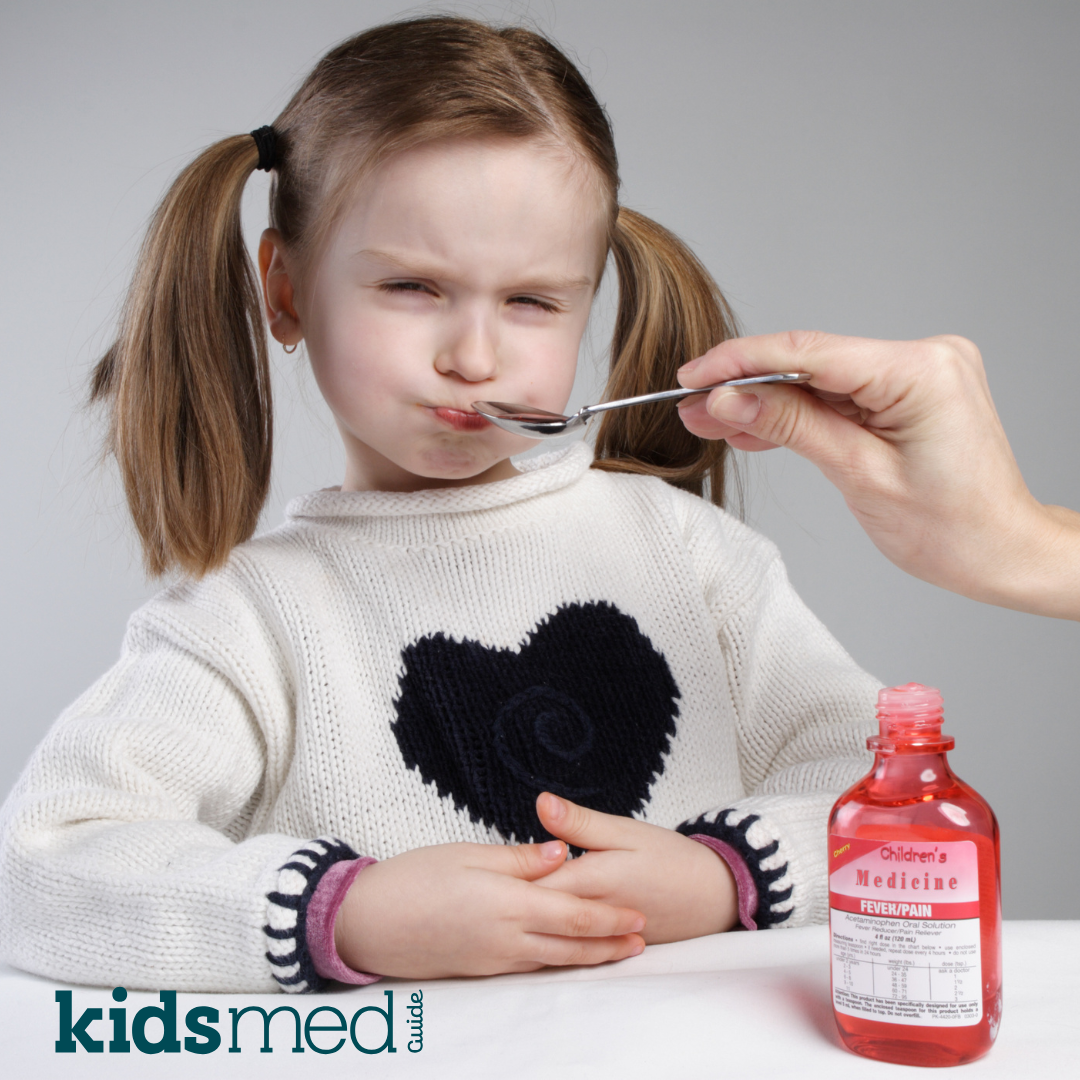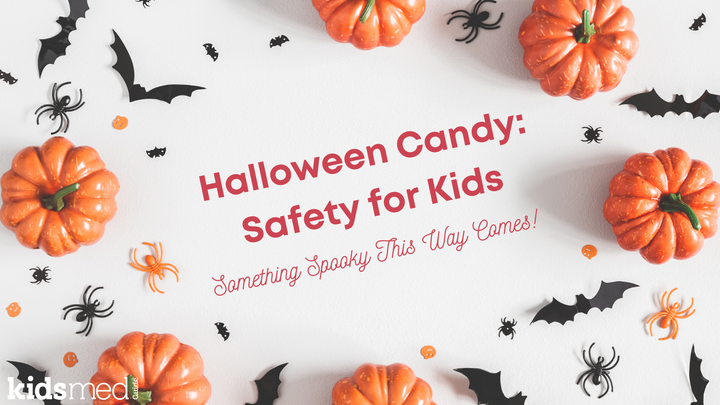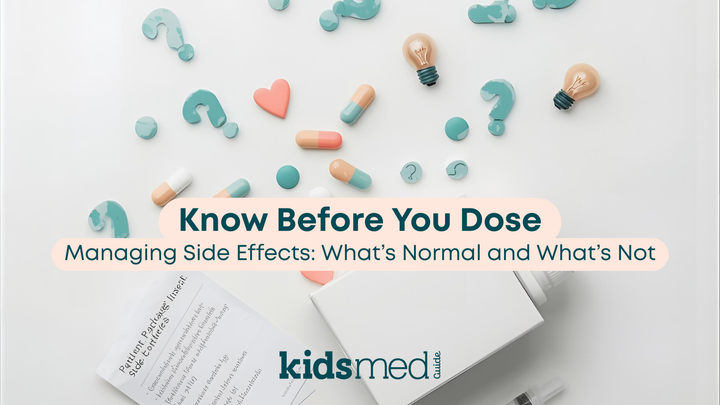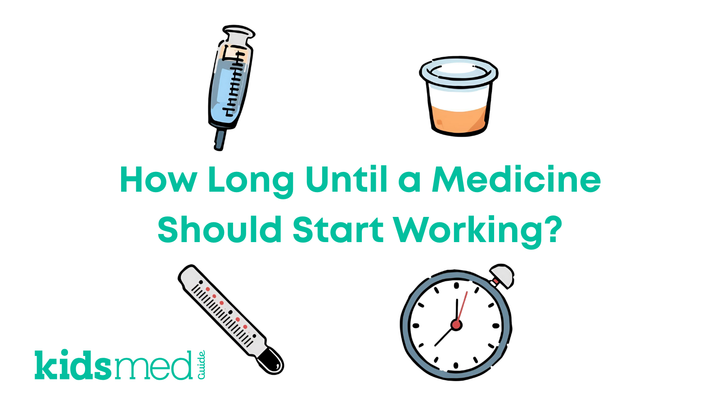What to Do When Your Kid Spits Out Their Antibiotics

Has anyone else ended up with white, chalky Augmentin liquid all over their face and hair after their kid immediately gags and violently spits a dose out? No? Just me?
Kids spitting out antibiotics that don’t taste well is an all-too-common scenario for parents. Some antibiotics, such as amoxicillin, are generally mild and pleasant enough in taste that many children will accept them without issue.
Others, such as Augmentin, are a bit grosser, thicker, and more likely to be rejected. Then there are the truly disgusting antibiotics, such as clindamycin, which cause nearly all children to turn their noses up and run in the opposite direction.
If your child spits out their antibiotics, fear not. Here are some general guidelines on what to do!
Should I Give Another Dose of Medication?
If your child immediately spits out a dose of medication the second it hits their mouth, it’s generally safe to assume that they received no medication or only a very small amount. Check what’s in their mouth compared to what is on the floor, on your shirt, or in your hair. If there’s very little in their mouth and a lot elsewhere, it’s fine to try another dose.
If your child swallows some or most of it but refuses some or spits some out, this is where it gets tricky. Don’t automatically re-dose. Make your best guess about how much they may have swallowed, and be particularly cautious with your estimate. If you think they swallowed 25-50% of the dose, it’s better to estimate that 50% of the dose was swallowed.
Next, call your pharmacist or pediatrician for advice on what to do. Many antibiotics have a very broad dose range, and a re-dose in this situation would be safe and preferred. However, some antibiotics have a narrow dose range, so giving a repeat dose could be more harmful than helpful.
Depending on the drug in question and your estimation of how much the child may have swallowed, your pharmacist or pediatrician could advise you to skip the rest of the dose altogether, re-dose the entire amount, or give a partial re-dose, based on how much your child likely swallowed.
How Do I Give Another Dose of Medication?
If it is appropriate to re-dose after your child spits out some or all of their medicine, you’ll need to be creative in your approach! If they spit it out the first time, they are likely to do it again… this time with a vengeance!
Try the following tips and tricks:
- Distract them
- Offer rewards and praise
- Consider dividing the dose into smaller amounts
- Chase the medication with something tasty, or mix the dose into a very small portion of applesauce or chocolate syrup (*double-check the package insert or with your pharmacist to be sure that the medicine can be taken with food)
- Utilize an oral dosing syringe rather than a cup, and gently squirt the dose into the back of the child’s cheek.
- Contact your pharmacy to check if they can offer a different flavor.
- Reach out to your doctor to see if there’s an alternative drug formulation or a completely different medication you can try.
Read our Ultimate Guide to Getting Your Child to Take Yucky Medicine!
Can My Doctor Switch Medications?
If you’ve tried all the tricks and your child just won’t swallow the medicine without a major battle, contact your pediatrician. There is usually more than one option for a pediatric antibiotic. Your doctor might suggest a different form, such as a tablet, or an entirely different medication altogether.
In extreme cases, there are sometimes injectable options. While this may not be ideal for the child or the parent, courses of antibiotics administered via injection may be significantly shorter and could result in less overall misery.
Can I Skip Doses?
Nope. If your pediatrician prescribes antibiotics, it’s to treat a bacterial infection. The bacterial infection won’t improve unless your child completes the entire course of medication as directed.
Antibiotic courses for kids can be lengthy, sometimes lasting 10 to 14 days! Depending on how the antibiotic works and what it’s treating, it truly requires this many doses to eliminate the infection.
Antibiotics That Taste Good
“Good” is relative here, folks. Some kids might take these cheerfully enough, while others may grimace and groan. However, most kids will accept these antibiotics without much fuss.
Antibiotics that have an acceptable taste:
- Amoxicillin (this is the universal favorite. I mean, who doesn’t like bubblegum?!)
- Cefdinir
- Cefuroxime
- Cefixime
- Azithromycin
- Doxycycline
Antibiotics That Taste Bad
Once again, this is relative. Some kids might not mind these medications. Other kids believe that all medicine tastes bad and there’s no level of badness. If your child is prescribed one of these drugs and you know they are particular about their taste preferences, you may want to have it flavored or employ your best tricks proactively.
These are the drugs that are most notorious for being refused:
- Penicillin
- Clindamycin
- Augmentin (amoxicillin-clavulanic acid)
- Cephalexin
- Bactrim (sulfamethoxazole-trimethoprim)
- Ciprofloxacin
Other Things to Consider
Anyone who has raised a toddler or preschooler knows that eating and drinking are multi-sensory experiences. By that, I mean it’s not just about how it tastes—how it looks, feels, and smells is equally important! It’s like how the carrots can’t touch the chicken on the dinner plate, or the entire meal is ruined.
If your child hates pink and the medicine is pink, you may have already lost the battle. If it has a strange smell and they are sensitive to odors, they may refuse it outright. You get the idea. Try to get ahead of this if you can. Ideas include:
- Mix a small amount of a differently colored substance, such as chocolate or strawberry syrup, applesauce, or yogurt, with the antibiotic. I’ve even heard of a parent trying frosting before!
- Check with your pharmacist that it is safe to do so
- Only mix in small amounts so your child will take the entire dose
- Have your child pinch their nose before the medication approaches, but make it a fun game.
- Use an oral dosing syringe instead of a cup to conceal the medication's appearance and color.
And finally....
Tips on How to Get Antibiotic Stains Out of Fabrics and Off Walls if Your Child Spits a Dose Out Everywhere
I don’t have any. If you do, please let me know!
Related:
How to Get Your Toddler to Take Yucky Medicine
The following references were used to compile this information:
Elgammal, A., Ryan, J., Bradley, C., Crean, A., & Bermingham, M. (2025). Challenges prescribing and dispensing oral antibiotics with poor palatability for paediatric patients: A qualitative interview study with GPs and pharmacists. Exploratory Research in Clinical and Social Pharmacy, 17, 100546. https://doi.org/10.1016/j.rcsop.2024.100546
Kirchner, J. T. (2000). Which Oral Antibiotics Do Children Find Most Palatable? American Family Physician, 62(6), 1393–1394.
Soares, N., Mitchell, R., McGoff, T., Bailey, T., & Wellman, G. S. (2022). Taste Perceptions of Common Pediatric Antibiotic Suspensions and Associated Prescribing Patterns in Medical Residents. The Journal of Pediatric Pharmacology and Therapeutics : JPPT, 27(4), 316–323. https://doi.org/10.5863/1551-6776-27.4.316



